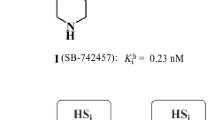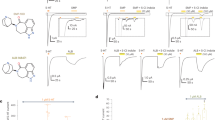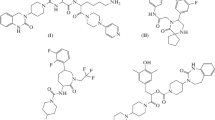Abstract
The discovery and classification of the 5-HT4 receptor was greatly facilitated by identification of ligands that interacted with this receptor and that provided tools for the elucidation of receptor signaling and function. Thus tropisetron (ICS-205 930,1⋆) was found to be a weak antagonist of 5-HT induced stimulation of adenylate cyclase activity in primary cultures of mouse embryo colliculi neurones with an apparent inhibition constant (Ki) of 997 nM.1 Tropisetron was also reported to inhibit 5-HT stimulated adenylate cyclase activity in guinea pig hippocampus with a pKi of 7.6,2 and the connection thereby established between the 5-HT receptor responsible for the observed activity in these two CNS preparations was largely responsible for the proposed classification of the 5-HT4 receptor (for reviews see refs. 3–5). The subsequent finding that certain members of the benzamide family of gastrointestinal prokinetic agents were agonists of the 5-HT4 receptor in mouse embryo colliculi neurones6 and in guinea pig hippocampus7 represented the first step in the functional characterization of this receptor. The benzamides used in these seminal studies were, in decreasing order of potency, cisapride (2), renzapride (3), zacopride (4), BRL 20627 (5) and the progenitor of the benzamide class metoclopramide (6). Whereas tropisetron and the benzamides played a pivotal role in establishing the existence of the 5-HT4 receptor, the utility of these drugs in the further characterization of the pharmacology of this receptor was severely limited by lack of selectivity. Tropisetron, renzapride and zacopride are high affinity 5-HT3 receptor antagonists,8 and cisapride and metodopramide have affinity for multiple receptor types.9 This chapter describes the significant progress made in the medicinal chemistry of 5-HT4 receptor ligands subsequent to the identification of these early leads which has resulted in the discovery of potent and selective 5-HT4 receptor agonists and antagonists, several of which are currently undergoing clinical evaluation. A previous review has admirably covered certain aspects of the medicinal chemistry of 5-HT4 receptor antagonists, most notably the structural relationships between 5-HT3 and 5-HT4 receptor antagonists.10
Access this chapter
Tax calculation will be finalised at checkout
Purchases are for personal use only
Preview
Unable to display preview. Download preview PDF.
Similar content being viewed by others
References
Dumuis A, Bouhelal R, Sebben M et al. A nonclassical 5-hydroxytryptamine receptor positively coupled with adenylate cyclase in the central nervous system. Mol Pharmacol 1988; 34:880-887.
Dumuis A, Bouhelal R. Sebben M et al. A 5-HT receptor in the central nervous system positively coupled to adenylate cyclase is antagonized by ICS 205–930. Eur J Pharmacol 1988; 146:187–188.
Bockaert J, Fozard JR, Dumuis A et al. The 5-HT4 receptor: a place in the sun. Trends Pharmacol Sci 1992; 13:141–145.
Ford APDW, Clarke DE. The 5-HT4 receptor. Med Res Rev 1993; 13:633–662.
Eglen RM, Hegde SS. 5-Hydroxytryptamine (5-HT4) receptors: physiology, pharmacology and therapeutic potential. Exp Opin Invest Drugs 1996; 5:373–388.
Dumuis A, Sebben M, Boeckaert. The gastrointestinal prokinetic benzamide derivatives are agonists at the non-classical 5-HT receptor (5-HT4) positively coupled to adenylate cyclase in neurons. Naunyn-Schmiedeberg’s Arch Pharmacol 1989; 340:403–410.
Bockaert J, Sebben M, Dumuis A. Pharmacological characterization of 5-hydroxytryptamine4 (5-HT4) receptors positively coupled to adenylate cyclase in adult guinea pig hippocampal membranes: effects of substituted benzamide derivatives. Mol Pharmacol 1990; 37:408–411.
King FD. Structure activity relationships of 5-HT3 receptor antagonists. In: King FD, Jones BJ, Sanger GJ, eds. 5-Hydroxytryptamine-3 Receptor Antagonists. Boca Raton: CRC Press, 1994:1–44.
Flynn DL, Zabrowski DL, Becker DP et al. SC-53116: The first selective agonist at the newly identified serotonin 5-HT4 receptor subtype. J Med Chem 1992; 35:1486–1489.
Gaster LM, King FD. Sertonin 5-HT3 and 5-HT4 receptor antagonists. Med Res Rev 1997; 2:163–214.
Craig DA, Clarke DE. Pharmacological characterization of a neuronal receptor for 5-hydroxytryptamine in guinea pig ileum with properties similar to the 5-hydroxytryptamine4 receptor. J Pharmacol Exp Ther 1990; 252:1378–1386.
Wardle KA, Sanger GJ. The guinea-pig distal colon—a sensitive preparation for the investigation of 5-HT4 receptor-mediated contractions. Br J Pharmacol 1993; 110:1593–1599.
Baxter GS, Craig DA, Clarke DE. 5-Hydroxytryptamine4 receptors mediate relaxation of the rat oesophageal tunica muscularis muco-sae. Naunyn-Schmiedeberg’s Arch Pharmacol 1991; 343: 439–446.
Grossman CJ, Kilpatrick GJ, Bunce KT. Development of a radioligand binding assay for 5- HT4 receptors in guinea-pig and rat brain. Br J Pharmacol 1993; 109:618–624.
Brown AM, Young TJ, Patch TL et al. [~~5I]-SB 207710, a potent, selective radioligand for 5-HT4 receptors. Br J Pharmacol 1993; 110:109.
Droppleman DA, Gregory RL, Alphin RS. A simplified method for assesssing drug effects on gastric emptying in rats. J Pharmacol Meth 1980; 4:227–230.
Banner SE, Smith MI, Sanger GJ. 5-HT receptors and 5-hydroxytryptophan-evoked defacation in mice. Br J Pharmacol 1993; 110:135P.
Bingham S, King BF, Rushant B et al. Antagonism by SB 204070 of 5-HT-evoked contractions in the dog stomach: an in-vivo model of 5-HT4 receptor function. J Pharm Pharmacol 1995; 47:219–222.
Banner SE, Smith MI, Bywater D et al. 5-HT4 receptor antagonism by SB 204070 inhibits 5-hydroxytryptophan-evoked defaecation in mice. Br J Pharmacol 1993; 110:179.
Hegde SS, Moy TM, Perry M et al. Evidence for the involvement of 5-HT4 receptors in 5- hydroxytryptophan-induced diarrhea in mice. J Pharmacol Exp Ther 1994; 271:741–747.
Villalon CM, Den Boer MO, Heligers JP et al. Further characterization, by the use of tryptamine and benzamide derivatives, of the putative 5-HT4 receptor mediating tachycardia in the pig. Br J Pharmacol 1991; 102:107–112.
Eglen RM, Alvarez R, Johnson LG et al. The action of SDZ 205,557 at 5-hydroxytrypamine (5-HT3 and 5-HT4) receptors. Br J Pharmacol 1993; 108:376–382.
Fontana DJ, Daniels SE, Wong EHF et al. The effects of novel, selective 5-hydroxytryptamine (5-HT4) receptor ligands in rat spatial navigation. Neuropharmacol 1997; 36:689–696.
Buchheit KH, Gamse R, Pfannkuche HJ. SDZ 205–557, a selective, surmountable antagonist for 5-HT4 receptors in the isolated guinea pig ileum. Naunyn-Schmiedeberg’s Arch Pharmacol 1992; 345:387–393.
Susemichel AD, Sandusky GE, Cohen ML. 2nd International symposium on serotonin 1992. Houston, Abst. P49.
Eglen RM, Bley K, Bonhaus DW et al. RS-23597–19o: a potent and selective 5-HT4 receptor antagonist. Br J Pharmacol 1993; 110: 119–126.
Gale, JD, Grossman CJ, Whitehead JWF et al. GR113808: a novel, selective antagonist with high affinity at the 5-HT4 receptor. Br J Pharmacol 1994; 111: 332–338.
Gaster LM, Jennings AJ, Joiner GF et al. (1-Butyl-4-piperidinyl)methyl 8-amino-7-chloro-1,4-benzodioxane-5-carboxylate hydrochloride: a highly potent and selective 5-HT4 receptor antagonist derived from metoclopramide. J Med Chem 1993; 36:4121–4123.
Dumuis A, Sebben M, Monferini E et al. Azabicycloalkyl benzimidazolone derivatives as a novel class of potent agonists at the 5-HT4 receptor positively coupled to adenylate cyclase in brain. Naunyn-Schmiedeberg’s Arch Pharmacol 1991; 343:245–251.
Turconi M, Schiantarelli P, Borsini F et al. Azabicycloalkyl benzimidazolones: interaction with serotonergic 5-HT3 and 5-HT4 receptors and potential therapeutic implications. Drugs of the Future 1991; 16:1011–1026.
Schiavone A, Giraldo E, Giudici L et al. DAU 6285: a novel antagonist at the putative 5-HT4 receptor. Life Sci 1992; 51:583–592.
Croci T, Langlois M, Mennini T et al. ML 10302, a powerful and selective new 5-HT4 receptor agonist. Br J Pharmacol 1995; 114: 382P.
Clark RD, Jahangir A, Langston JA et al. Ketones related to the benzoate 5-HT4 receptor antagonist RS-23597 are high affinity partial agonists. Bioorg Med Chem Lett 1994; 4:2477–2480.
Elz S, Keller A. Preparation and in vitro pharmacology of 5-HT4 receptor ligands. Partial agonism and antagonism of metoclopramide analogous benzoic esters. Arch Pharm 1995; 328:585–594.
Langois M, Zhang L, Yang D et al. Design of a potent 5-HT4 receptor agonist with nanomolar affinity. Bioorg Med Chem Lett 1994; 4:1433–1436.
Yang D, Soulier JL, Sicsic et al. New esters of 4-amino-5-chloro-2methoxlybenzoic acid as potent agonists and antagonists for 5-HT4 receptors. J Med Chem 1997; 40:608–621.
Hadley MS, King FD, McRitchie B et al. Substituted benzamides with conformationally restricted side chains. 1. Quinolizidine derivatives as selective gastric prokinetic agents. J Med Chem 1985; 28:1843–1847.
Hadley MS, King FD, McRitchie B et al. Substituted benzamides with conformationally restricted side chains. 3. Azabicyclo[x.y.o] derivatives as gastric prokinetic agents. Bioorg Med Chem Lett 1992; 2:1147–1152.
Hadley MS, King FD, McRitchie B et al. Substituted benzamides with conformationally restricted side chains. 4. Hetero-azabicyclo[x.y.o] derivatives as gastric prokinetic agents. Bioorg Med Chem Lett 1992; 2:1293–1298.
King FD, Hadley MS, Joiner KT et al. Substituted benzamides with conformationally restricted side chains. 5. Azabicyclo[x.y.z] derivatives as 5-HT4 receptor agonists and gastric motility stimulants. J Med Chem 1993; 36:683–689.
Baxter GS, Boyland P, Gaster LM et al. Quaternized renzapride as a potent and selective 5-HT4 receptor agonist. Bioorg Med Chem Lett 1993; 3:633–634.
Becker DP, Goldstin B, Gullikson GW et al. Design and synthesis of agonists and antagonists of the serotonin 5-HT4 receptor subtype. Pharmacochem Libr (Perspectives in Receptor Research) 1996; 24:99–120.
Flynn DL, Becker DP, Spangler DP et al. New aza(nor)adamantanes are agonists at the newly identified serotonin 5-HT4 receptor and antagonists at the 5-HT3 receptor. Bioorg Med Chem Lett 1992; 2:1613–1618.
Gullikson GW, Virina MA, Loeffler RF et al. SC-49518 enhances gastric emptying of solid and liquid meals and stimulates gastrointestinal motility in dogs by a 5-hydroxytryptamine4 receptor mechanism. J Pharmacol Exp Ther 1993; 264:240–248.
Langlois M, Yang D, Bremont B et al. Synthesis and pharmacological activity of a macrocyclic benzamide. Bioorg Med Chem Lett 1995; 5:795–798.
Clark RD, Weinhardt KK, Berger J et al. N-(quinuclidin-3-yl)1,8naphthalimides with 5- HT3 receptor antagonist and 5-HT4 receptor agonist properties. Bioorg Med Chem Lett 1993; 3:1375–1378.
Eglen RM, Bonhaus DW, Clark RS et al. (R) and (S) RS 56532: mixed 5-HT3 and 5-HT4 receptor ligands with opposing enantiomeric selectivity. Neuropharmacol 1994; 33:515–526.
Fontana DJ, Wong EHF, Clark R et al. Procognitive effects of RS-66331, a mixed 5-HT3 receptor antagonist/5-HT4 receptor agonist. Proceedings of the Third IUPHAR Satellite Meeting on Serotonin. Chicago 1994:57:abst 1.
Eglen, RM, Wong EHF, Dumois et al. Central 5-HT4 receptors. Trends Pharmacol Sci 1995; 16:391–398.
Fancelli D, Caccia C, Fornaretto MG et al. Serotonergic 5-HT3 and 5-HT4 receptor activities of dihydrobenzofuran carboxylic acid derivatives. Bioorg Med Chem Lett 1996; 6:263–266.
Blum E, Buchheit KH, Buescher HH et al. Design and synthesis of novel ligands for the 5- HT3 and 5-HT4 receptor. Bioorg Med Chem Lett 1992; 2:461–466.
Fernandez AG, Kelly ME, Puig J et al. LAS Z-019, a new centrally acting 5-HT4 agonist. Methods Find Exp Clin Pharmacol 1994; 16, suppl 1: 99.
Briejer, MR, Akkermans LMA, Meulemans AL et al. Cisapride and a structural analog, R 76186 are 5-hydroxytryptamine4 (5-HT4) receptor agonists on the guinea pig colon ascendens. NaunynSchmiedeberg’s Arch Pharmacol 1993; 347:464–470.
Kawakita T, Kuroita T, Murozone T. New benzoic acid derivatives are 5-HT4 receptor agonists. Int Pat Appl 1997; WO 97/006452.
Yoshida, N. Pharmacological studies on mosapride citrate (AS-437o), a gastroprokinetic agent. (1). Comparison with cisapride and metoclopramide. Yakuri to Chiryo 1993; 21:3013–3028. Chem Abst 120:95340 (1997).
Matsuyama S, Sakiyama H, Nei K. Identification of putative 5-hydroxytryptamine4 (5-HT4) receptors in guinea pig stomach: the effect of TKS159, a novel agonist, on gastric motility and acetylcholine release. J Pharmacol Exp Ther 1996; 276:989–995.
Eglen RM, Bonhaus DW, Johnson LG et al. Pharmacological characterization of two novel and potent 5-HT4 receptor agonists, RS 67333 and RS 67506, in vitro and in vivo. Br J Pharmacol 1995; 115:1387–1392.
Buchheit KH, Gamse R, Giger R et al. The serotonin 5-HT4 receptor. 1. Design of a new class of agonists and receptor map of the agonist recognition site. J Med Chem 1995; 38:2326–2330.
Buchheit KH, Gamse R, Giger R et al. The serotonin 5-HT4 receptor. 2. Structure-activity studies of the indole carbazimidamide class of agonists. J Med Chem 1995; 38:2331–2338.
Appel S, Kumle A, Hubert M et al. First pharmacokinetic-pharmacodynamic study in humans with a selective 5-hydroxytryptamine4 receptor agonist. J Clin Pharmacol 1997; 37229–237.
Appel, S, Lemarechal MO, Kumle A et al. Simultaneous p.o. and i.v. pharmacokinetic modeling of the novel selective 5-HT4 receptor agonist SDZ HTF 919 in humans. 98th Ann Meeting Am Soc Clin Pharmacol Ther, San Diego 1997; poster P1–85.
Romanelli MN, Ghelardini C, Die S et al. Synthesis and biological activity of a series of aryl tropanyl esters and amides chemically related to 1H-indole-3-carboxylic acid endo 8-methyl-8-azabicyclo[3.2.1]oct-3-yl ester. Arzneim-Forsch/Drug Res 1993; 43:913–918.
Ramirez MJ, Garcia-Garayoa E, Monge A. VB2oB7, a novel 5-HTergic agent with gastrokinetic activity. I. Interaction with 5-HT3 and 5-HT4 receptors. J Pharm Pharmacol 1997; 4958–65.
Gaster LM, Sanger GJ. SB 204070: 5-HT4 receptor antagonists and their potential therapeutic utility. Drugs of the Future 1994; 19:1109–1121.
Gaster LM. 8th RSC-SCI medicinal chemistry symposium. Cambridge. 1995.
Wardle KA, Ellis ES, Baxter GS et al. The effects of SB 204070, a highly potent and selective 5-HT4 receptor antagonist, on guinea-pig distal colon. Br J Pharmacol 1994; 112789–794.
Hegde SS, Bonhaus DW, Johnson LG et al. RS-396o4: a potent, selective and orally active 5-HT4 receptor antagonist. Br J Pharmacol 1995; 115:1087–1095.
Yang DC, Goldstin B, Moorman AE et al. SC-536o6, a potent and selective antagonist of 5-hydroxytryptamine4 receptors in isolated rat esophagial tunica muscularis mucosae. J Pharmacol Exp Ther 1993; 266:1339–1347.
Orjales A, Alonso-Cires L, Labeaga L et al. New substituted benzamides as 5-HT4 receptor antagonists. Eur J Med Chem 1995; 30:651–654.
Clark RD, Jahangir A, Langston JA et al. Synthesis and preliminary pharmacological evaluation of 2-benzyloxy substituted aryl ketones as 5-HT4 receptor antagonists. Bioorg Med Chem Lett 1994; 4:2481–2484.
Clark RD, Jahangir A, Flippin LA et al. RS-100235: a high affinity 5-HT4 receptor antagonist. Bioorg Med Chem Lett 1995; 5:2119–2122.
Gale JD, Grossman CJ, Darton J et al. GR125487: a selective and high affinity 5-HT4 receptor antagonist. Br J Pharmacol 1994; 113:120.
Gale JD, Green A, Darton J et al. GR12S487: a 5-HT4 receptor antagonist with a long duration of action in vivo. Br J Pharmacol 1994; 113:119P.
King DF, Gaster LM, Mulholland KR. 5-HT4 receptor antagonists. Int Pat Appl 1994; WO 94/27987.
Parker SG, Hamburger S, Taylor EM et al. SB203186, a potent 5-HT4 receptor antagonist, in porcine sinoatrial and human and porcine atriuim. Br J Pharmacol 1993; 108:68P.
Wyman PA, Gaster LM, King FD et al. Azabicyclo indole esters as potent 5-HT4 receptor antagonists. Bioor Med Chem 1996; 4:255–261.
Gaster LM, Joiner GF, King FD et al. N-[(1-butyl-4-piperidinyl)methyl]-3,4-dihydro-2H- [1,3] oxazino [3,2-a]indole-lo-carboxamide hydrochloride: The first potent and selective 5- HT4 receptor antagonist amide with oral activity. J Med Chem 1995; 38:4760–4763.
Gaster LM, Wyman PA, Ellis ES et al. 5-HT4 receptor antagonists: oxazolo, oxazino and oxazepino[3,2-a]indole derivatives. Bioorg Med Chem Lett 1994; 4:667–668.
Wardle KA, Bingham S, Ellis ES et al. Selective and functional 5hydroxytryptamine4 receptor antagonism by SB 207266. Br J Pharmacol 1996; 118:665–670.
King FD. Modulators of 5-HT function in the treatment of gastrointestinal disorders. nth Noordwijkerhout-Camerino symposium-Trends in Drug Research, Noordwijkerhout, The Netherlands 1997: lecture 18.
Kennet GA, Bright F, Trail B et al. Anxiolytic-like actions of the selective 5-HT4 receptor antagonists SB 204o70A and SB 2o7266A in rats. Neuropharmacol 1997; 36:707–712.
Kaumann AJ, King FD, Young RC et al. Indazole as an indole bioisostere: 5-HT4 receptor antagonism. Bioorg Med Chem Lett 1992; 2:419–420.
Cohen ML, Bloomquist W, Schaus JM et al. LY353433, a potent, orally effective, long-acting 5-HT4 receptor antagonist: Comparison to cisapride and RS-23597–19o. J Pharmacol Exp Ther 1996; 277:97–104.
Hagihara K, Hayakawa T, Arai T et al. Antagonistic activities of N3389, a newly synthesized diazabicyclo derivative, at 5-HT3 and 5-HT4 receptors. Eur J Pharmacol 1994; 271:159–166.
Buchheit KH, Klein F, Kloppner E et al. The serotonin 5-HT4 receptor: Part 3: Design and pharmacological evaluation of a new class of antagonists. Bioorg Med Chem Lett 1995; 5:2495–2500.
Oxford AW. Substituted phenylcarbamates and phenylureas, their preparation and their use as 5-HT antagonists. Int Pat Appl 1993; WO 93/20071.
Soulier JL, Yang D, Bremont B et al. Arylcarbamate derivatives of 1piperidineethanol as potent ligands for 5-HT4 receptors. J Med Chem 1997; 40:1755–1761.
Gaster LM, Joiner GF, Mulholland KR et al. Preparation of Nalkylpiperidinyl-4-methyl carboxylic esters/amides of condensed ring systems as 5-HT4 receptor antagonists. Int Pat Appl 1993; WO 93/ 20071.
Cereda E, Bignotti M, Martino V et al. Preparation of i-substitutedpiperidin-4-ylmethyl esters and amides as 5-HT4 antagonists. Int Pat Appl 1996; WO 96/28424.
Sanger GJ, King FD, Baxter GS. Use of heterocyclic derivatives as 5-HT4 receptor antagonists-for treating or preventing gastrointestinal, cardiovascular and central nervous system disorders. Int Pat Appl 1993; WO 93/02677.
Jegham S, Galli F, Nedelec A et al. New 5-phenyl-3-(piperidin-4-yl)1,3,4-oxadiazol-2(3H)-one derivatives are 5-HT4 or 5-HT3 receptor ligands. Int Pat Appl 1997;WO 97/006383.
Jegham S, Lochead A, Galli F et al. New 5-phenyl-3-(piperidin-4-yl)1,3,4-oxadiazol-2(3H)-one derivatives. Int Pat Appl 1997;WO 97/006995.
Leung E, Pulido-Rios MT, Bonhaus DW et al. Comparison of 5-HT4 receptors in guinea-pig colon and rat oesophagus: effects of novel agonists and antagonists. Naunyn- Schmiedeberg’s Arch Pharmacol 1996; 354:145–156.
Bonhaus DW, Berger J, Adham N et al. [3H]RS 57639, a high affinity, selective 5-HT4 receptor partial agonist, specifically labels guinea-pig striatal and rat cloned (5-HT4s and 5 HT4L) receptors. Neuropharmacol 1997; 36:671–679.
Editor information
Editors and Affiliations
Rights and permissions
Copyright information
© 1998 Springer-Verlag Berlin Heidelberg
About this chapter
Cite this chapter
Clark, R.D. (1998). Medicinal Chemistry of 5-HT4 Receptor Ligands. In: Eglen, R.M. (eds) 5-HT4 Receptors in the Brain and Periphery. Biotechnology Intelligence Unit. Springer, Berlin, Heidelberg. https://doi.org/10.1007/978-3-662-05553-3_1
Download citation
DOI: https://doi.org/10.1007/978-3-662-05553-3_1
Publisher Name: Springer, Berlin, Heidelberg
Print ISBN: 978-3-662-05555-7
Online ISBN: 978-3-662-05553-3
eBook Packages: Springer Book Archive




